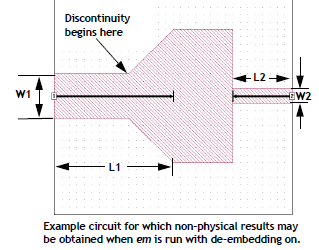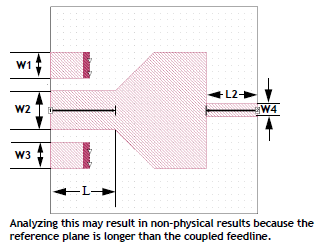Generally, reference planes should not be longer than the feedline(s) attached to the port. This is because a reference plane is “negating” a transmission line. Thus if your reference plane is longer than your feedline, you are effectively attempting to negate a part of a transmission line which does not exist. Doing so may result in non-physical S-parameters.
To illustrate this problem, consider the valid circuit shown below. In this circuit, the reference planes are the same length as the feedlines. When de-embedding is enabled, the port 1 discontinuity is negated along with a transmission line of width W1 and length L1. Similarly, the port 2 discontinuity is negated along with a transmission line of width W2 and length L2. The de-embedded result is a set of 2-port S-parameters for the block in the middle of the circuit which is usually the desired data.

Now, consider the figure below. This circuit is identical to the circuit shown above except that the length of the reference plane associated with Port 1 has been increased. If em is run with de-embedding enabled on this circuit, it “negates” a length of transmission line equal to the specified reference plane length. This occurs even though the actual feed transmission line is shorter than the reference plane length. As a result, the de-embedded S-parameters may be non-physical (i.e., the results may not obey the laws of physics by being non-passive or non-causal).

A second de-embedding example leading to non-physical S-parameter results is shown in the next figure. In this example, the circuit has two via pads on each side of the port transmission line. The via pads are grounded to the box-wall.
When em is run with de-embedding enabled on this circuit, it “negates” three coupled feedlines with a length equal to the reference plane length. Since the reference plane extends from the boxwall beyond the vias, the de-embedded results may be non-physical.
